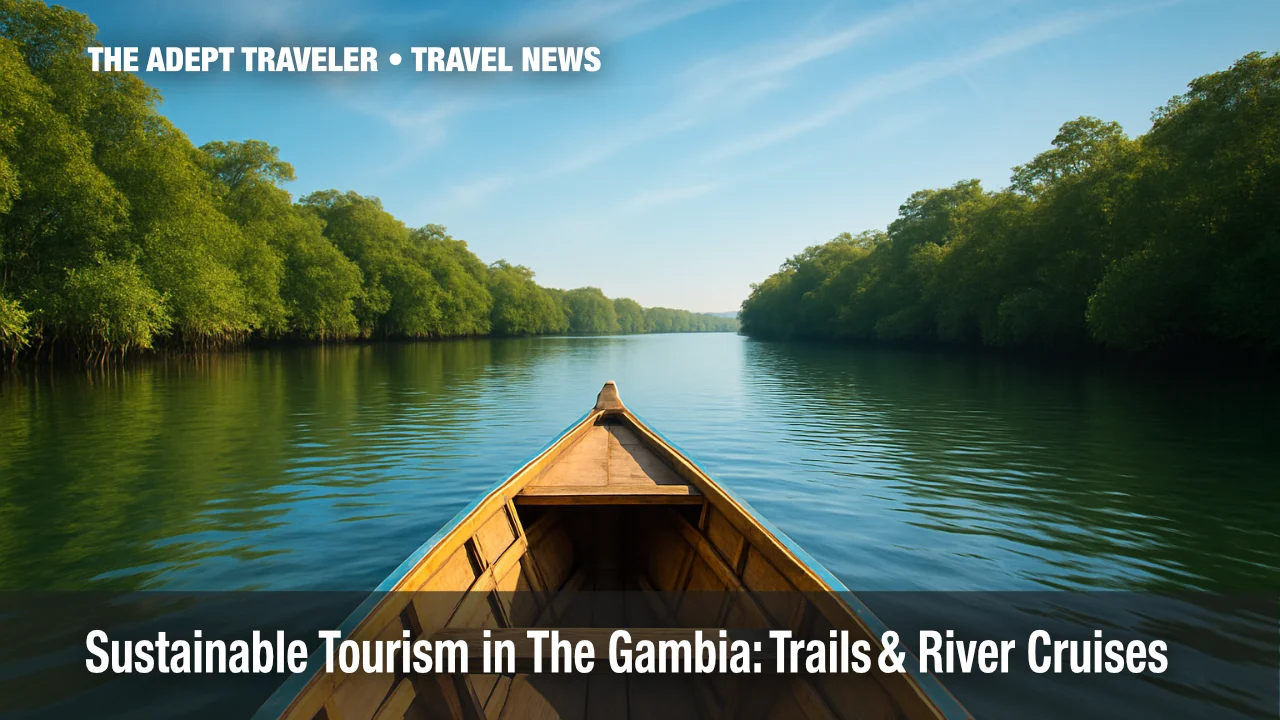How The Gambia Is Turning Trails and River Cruises into a Model of Sustainable Tourism

Sustainable tourism in The Gambia is rapidly moving beyond its famed beaches to showcase riverine wildlife, living culture, and genuine community encounters. From the grassroots Ninki Nanka Trail to small-ship cruises that venture deep into the River Gambia, new products aim to conserve fragile ecosystems while spreading tourist dollars upriver. For U.S. travelers seeking low-impact adventures, the Smiling Coast now offers a compact, English-speaking gateway to West African nature, history, and hospitality.
Key Points
- Why it matters: Tourism drives about 20 percent of The Gambia's GDP.
- Ninki Nanka Trail channels 100 percent of proceeds to village projects.
- Variety Cruises limits sailings to 44 passengers, reducing footprint.
- Awards in 2024 boosted the country's responsible-tourism profile.
- New Green Scales standard rates lodges on waste, water, and wildlife.
Sustainable Tourism in The Gambia Snapshot How It Works
The Gambia's eco offering hinges on two pillars. First, the 220-mile-long River Gambia acts as a blue corridor for birdlife, hippos, and the rare West African manatee. Operators such as Variety Cruises run seven-night itineraries on 44-passenger yachts, stopping at national parks and UNESCO stone circles while sourcing produce from riverside villages. Second, the Ninki Nanka Trail links more than a dozen communities from Banjul to Janjanbureh. Homestays, canoe trips, and storytelling performances are booked through a nonprofit foundation that certifies guides and reinvests fees locally. Trail packages cost £100-£400 per person (about $127-$509) including transport, lodging, and meals, keeping pricing transparent and benefits onshore.
Sustainable Tourism in The Gambia Background Why It Matters
Beach tourism once concentrated visitors in the short dry season, leaving rural areas with few dividends. A 2019 strategy by the Gambia Tourism Board and UNDP set targets to "diversify beyond sun-sand-sea," cut single-use plastics, and lift rural incomes. Community-based tourism was already familiar-bird-watch guides in Kiang West have welcomed enthusiasts since the 1990s-but lacked a coherent route. The Ninki Nanka Trail concept, named after a dragon of Mandinka folklore, stitched isolated village initiatives into a marketable circuit. In parallel, small-ship lines trialed seasonal cruises that sail upriver when water levels peak, proving that wildlife and culture cruises could lengthen the visitor calendar and open new revenue streams.
Sustainable Tourism in The Gambia Latest Developments
Recent activity shows momentum rather than marketing spin.
Community-Led Ninki Nanka Trail Expands Upcountry
This spring, the Ninki Nanka Encounters Foundation finished a new riverfront interpretive center in Janjanbureh, offering craft workshops and bike rentals. Four additional villages-Kaur, Sami Karandala, Georgetown North, and Kuntair-joined the trail after completing hospitality and waste-management training. The foundation's "Green Scales" audit now grades each homestay on energy use, grey-water recycling, and wildlife-friendly lighting, giving travelers a clear benchmark. Early data show participating households raising annual income by 28 percent since 2022, with women operating nearly half of new micro-businesses.
Variety Cruises Adds Low-Impact River Itineraries
Greece-based Variety Cruises confirmed a January-February 2026 season aboard the Harmony V, mirroring a 2025 schedule that has already sold out. The line offsets fuel emissions through mangrove-restoration projects near Tendaba and bans single-use plastic on board. It has also agreed to cap landing groups at 20 guests so rangers can manage wildlife viewing around Baboon Island's chimpanzee rehabilitation center. Local produce sourcing has jumped to 65 percent by value, with fishermen in Kuntaur supplying barracuda and bonga.
Awards and Green Standards Boost Visibility
Seven Gambian professionals made the Africa Travel 100 Global Leaders list in August 2024, spotlighting guides, hoteliers, and conservationists. The Ninki Nanka Trail itself was shortlisted for the Global Responsible Tourism Awards under the "Destinations Building Back Better" category. Separately, new government guidelines require beach-resort investors to include energy-audited river or rural excursions in package rates, nudging mainstream operators toward greener portfolios. U.S. advisors report a 30 percent year-to-date rise in requests that bundle coast stays with upcountry experiences, a trend expected to accelerate as nonstop charter flights from New York resume this winter.
Analysis
For U.S. travelers, The Gambia's small size is an advantage. Within three hours of landing in Banjul, guests can be gliding past mangroves alive with pied kingfishers or sipping attaya tea in a riverside compound. English is the official language, reducing friction for first-time Africa visitors. Health prep is similar to safari classics-yellow-fever vaccine plus malaria prophylaxis-yet costs remain lower because distances are short and lodgings are community-run. Advisors should vet operators for wildlife ethics: feeding crocodiles at Kachikally pool remains a tourist draw but contradicts best practice. Recommend dawn departures for birding, carry lightweight binoculars, and book trail segments with a certified Ninki Nanka guide to ensure revenue sharing. Clients drawn to river cruising elsewhere will appreciate the Harmony V's yacht scale, but motion-sensitive travelers should know that overnight anchoring can be humid despite air-con. Payments in cash are common; small USD bills still help during market stops, though ATMs in Banjul now accept major cards.
Final Thoughts
Sustainable tourism in The Gambia is maturing from niche experiment to nationwide strategy. Whether paddling a pirogue beside crimson-beaked kingfishers or learning batik techniques in a village women's co-op, travelers can directly support conservation and community livelihoods. Book flexible trail modules to match comfort levels, pack reef-safe sunscreen for river swims, and add an extra night in Banjul to sample kora music before heading home. With diligent operator choices and a respect for local customs, visitors will leave a lighter footprint while enjoying an unforgettable slice of West Africa.
Sources
- Sustainable Tourism Experiences in The Gambia
- Ninki Nanka Encounters Foundation: Responsible Community-Based Tourism
- Exploring the Gambia's New Ninki Nanka Trail - National Geographic Traveller UK
- Rivers of West Africa 2025 Itinerary - Variety Cruises
- Responsible Development of Community-Based Tourism in The Gambia - Leeds Beckett University
- Gambian Tourism Leaders Shine in Africa Travel 100 Global Leaders Awards 2024 - Alkamba Times
